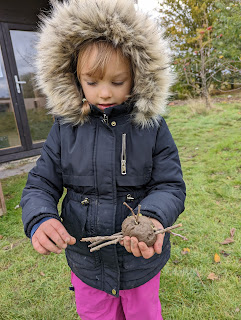Greetings, Hedgehogs and Hedgehog parents,
That was certainly a busy first week back! It's great to have the Reception children in full time and it was very good to catch up with all of you about your children's learning.
Park Keepers.
On Monday, we did Percy a huge favour. The birds living on his roof (the ones whose tree had fallen down) have been causing him a lot of problems with their early dawn chorus. We managed to plant and grow a new oak tree for them to live in. We looked at the shape of oak leaves and learnt about acorns and what they are for. Percy was very grateful.
Having seen how good the children were at rehoming the birds, Percy asked if they could rehome the other animals. We did some research about animal habitats, then the children worked in threes to create some suitable dreys, nests, dens and warrens on the field.
Unfortunately, later on the Park Keepers had a BIG problem. some people had built a bonfire in a corner of the park. Just as they lit the bonfire they discovered.... a hedgehog was nesting inside of it! Luckily the quick-thinking Park Keepers saved the hedgehog. As a result of this, the Year 1 children made some posters warning people to look out for hedgehogs in their bonfires. Here is Rupert and Arthur's poster (the heading reads 'Beware for (of) hedgehogs')
DiwaliDhwani and her mum helped us to celebrate along with Mrs Wright Diwali this year! The children loved their beautiful clothes and enjoyed learning about Diwali. Everyone took part in making some Rangoli patterns and a Diwali card, and doing some dancing with Mrs Wright. Thank you Mrs Chauhan for coming in.
Maths this week:
Reception children have been learning about the composition of 2 and 3.
They have learnt that '2 is one and another one' and that '2 and 1 make 3'.
A good game to play to practise subitising (using 'magic eyes' to 'just know' how many there are, without counting) is a game we play in school called (for example) 'Three or not three?' (you can choose any number to play this with).
To play 'Three or not three' with your child:
Have a teatowel and some items that will fit under the teatowel (counters, small teddies, sweets...).
Secretly put '3' or 'not 3' items under the teatowel. Do not put more than 5 items under there. Quickly reveal the items to your child and they have to call out 'Three!' or 'Not three!' before you cover the items back up. After they have given their answer, reveal the items to see whether they were right. If there are three items, talk about how your child knows. They might see 'I can see a 1 and 1 and 1' or 'I can see 2 there and 1 there'.
The idea is to help your child to subitise to three, but with the three objects in different arrangements, by quickly seeing that there are 2 and 1 or 1 and 1 and 1.
Year 1 children been subtracting by:
1) crossing out
2) making part whole diagrams
You can practise this by telling subtraction stories using teddies, plastic dinosaurs, (anything you can find!) and creating a large part-whole diagram for your child to work the problem out (using hoops, chalk, large paper... etc)
An example would be: 'There were ten dinosaurs. Four of them were standing at the edge of a pond. The rest were in the pond. How many were in the pond?'
Help your child to put the 'whole' (in this case, four dinosaurs) in the 'whole' part of the diagram, then subtract four (in this case) to place them into one part, and then place the rest of the dinosaurs into the other part of the diagram to find the answer.
Then tell another story!
A good maths mastery challenge for your child would be to ask them to do the subtraction storytelling themselves, and then show you how to find the answer.
Phonics this week:
Reception have now looked at s a t p i n m d g o c
You can practise initial sounds using these Eye Spy sheets:
O eye spy
C eye spy
You can also practice writing 'c' correctly. C is a very important shape for a lot of letters and it's important to start from the top and curl down to the line.
Year 1 have been revisiting the sounds we looked at before half term and practising putting sound buttons and lines on words. We put a button (a dot) under single letter sounds and a line under digraphs to help us to read words. This is particularly useful for reading 'alien' words.
If you don't have a printer, ask your child to draw lots of aliens and then you can give them names.
I think that's everything! Have a good weekend!
From Mrs Simpson
P.S. Here are a few Forest School photos:






















No comments:
Post a Comment